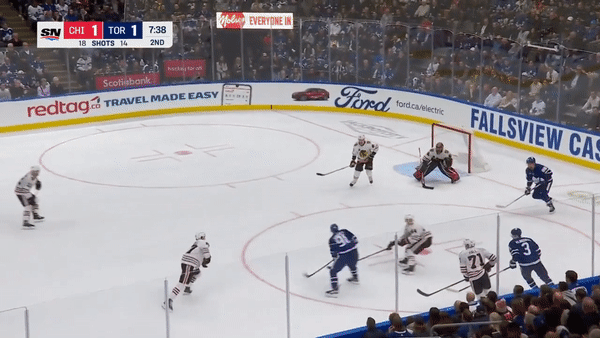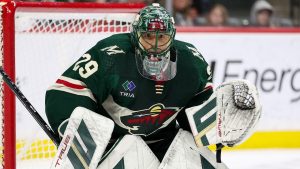If someone were to write a How to Defend William Nylander Without Looking Silly guide, it would basically begin and end with “don’t let him move with the puck.”
Based on how opponents have fared against the 27-year-old thus far this season, it’s safe to say they’ve largely failed on the implementation front.
When you watch Nylander play, it’s hard to really understand how he’s doing what he’s doing (AKA whatever he wants, it would seem) because on the surface, it often looks like he’s not doing much out of the ordinary. In other words, it’s easy to chalk his success up to simply being more talented than most and thus being able to execute at a higher level.
While true, becoming a top player in the NHL demands oodles of talent and an elite understanding of how to maximize said talent. More specifically, it requires pinpointing one’s greatest asset and designing a blueprint around it.
Nylander has done just that with his agility.
Only a handful of players in the league can shift their weight and move in different directions as quickly and seamlessly as the Leafs forward. As a result of structuring his game around this skill, he operates from a position of strength almost by default.
We’ll explore how Nylander’s created these conditions and uncover the many layers underlying his success in the process. To start, let’s look at the secondary skills he’s mastered to support his agility and then we’ll break down the movement habits he’s developed to leverage this primary skill.
SECONDARY SKILLS
There are four key skills that surround and complement Nylander’s agility, all of which seem to have become more technically sound and consistent this season, helping to elevate his game.
Let’s start with arguably the most overlooked attribute as it pertains to players in general.
Balance
Balance and agility are very much intertwined. While agility provides a player with a leg up when it comes to maneuvering to a spot or eluding an opponent or reaching a loose puck first, balance allows the player to maintain that advantage.
The greater capacity a player has to move without compromising their balance, the greater their ability to make a quality next play, which is where the real edge lies.
Nylander is a prime example of this principle. Sturdy on his edges, and adept at controlling his body and momentum, he regularly turns plays that look destined to die into dangerous chances and those heading south into ones quickly heading north.
The way he’s able to reset his posture in an instant and re-engage his feet without any hiccups to make that next play is impressive.
Below are some examples, including one where his balance is on full display twice in a span of three seconds (see last clip).
Upper-body stability
Nylander’s exceptional balance can in large part be attributed to his strong core and quiet upper body, which impacts his posture (ability to keep his chest and head up) and how his weight is stacked.
This facet of his game has improved significantly over the years. We can see this progression early on in his career courtesy of two videos where he practices an identical crossover exercise.
It’s fascinating to see how his upper body – specifically his arms – becomes much more still and how that impacts his balance. The first clip is from his third NHL season and the second from his fifth season.
His strength and stability have only continued to improve since then.
In addition to aiding with balance, less upper-body activity makes it easier to move fluidly and handle pucks smoothly, which brings us to…
Catching difficult pucks
Being able to consistently catch the puck cleanly without breaking stride – particularly on bounces, rims, or one’s backhand – is the kind of underrated skill that separates great players from elite ones.
Nylander shines in this area.
Bobbling the puck for a split second on first touch, which seems to be more of a rarity for the Swede this season thanks to his timing and coordination, is often the difference between being in control of how a sequence unfolds and being at the mercy of one’s opponent. This factor can determine whether or not a player is able to pull away from defenders, get to the middle of the ice, or take advantage of passing lanes before they disappear.
Nylander has become a pro at translating his capacity to receive pucks cleanly in stride into opportunities to use his agility more frequently, blending the two together in a way that swiftly parlays catches into chances.
Hip pocket position
Last up is how No. 88 holds the puck at his forehand hip pocket and makes a point of pulling it into this position quickly.

The reason? He can move freely in any direction from here, maximizing his range of motion.
He can also do anything with the puck (stickhandle, pass, shoot) while keeping his intentions concealed, hence why this position is considered the most deceptive.
MOVEMENT HABITS
Expanding and enhancing a core skill by improving the subtle skills around it is one thing, but developing habits to effectively leverage it is another.
Nylander has achieved the latter, stitching three main movement patterns into the fabric of his game.
Here’s 18 seconds of him dominating the Blackhawks earlier this season, mostly because it’s fun but also because it gives us a preview of all three:

As we dig into these three patterns, we’ll see how they allow him to maximize his agility and create competitive advantages for himself.
Taking curved or diagonal routes
Nylander’s specialty is manipulating the positioning of defenders to ensure they’re perpetually a step behind. The shape of his path with the puck is one variable that plays a central role in the creation of these conditions.
By skating on curves or diagonals (primarily using crossovers) rather than in straight lines, he unlocks the capacity to dictate the routes of defenders and the direction their weight is leaning. Exploiting their positioning with his agility then becomes a breeze.
He also buys himself more time and space to operate by widening the gap between himself and his defender in the process.
Once this power dynamic has been established, Nylander typically has one of two objectives in mind.
The first: pull his defender to an area that allows him to preserve space elsewhere to make his next play.
This one usually involves Nylander forcing defenders to alter their routes, only to toy with their feet and balance again the moment they recover. We’ll call this the “you zig, I zag” tactic and, man, it must be annoying for the guy covering him.
He eventually baits this player into overcommitting in a certain direction (often by changing his speed) and then uses the ice he’s manufactured, and his skating, to his advantage.
Here are a couple examples:
This quote from Minnesota’s Marcus Johansson, who ended up with the unfortunate task of defending Nylander on the overtime winner in our first clip, speaks to how effectively the winger deploys this tactic:
“I tried. I thought I had him on the outside enough. But he’s a very skilled player. He got a little bit of room and that was enough. Frustrating.”
That little bit of room was no accident.
The other objective Nylander has in mind, when he’s not interested in zigging and zagging, revolves around changing his angle of attack to step around a defender.
He’ll again move in one direction to set the defender’s route, only to change the angle he sold with a hard stride in a different direction as coverage approaches. His agility allows him to pull away from there.
Darryl Belfry, a player development coach who’s worked with Nylander for years, recently alluded to how the game’s top players choreograph sequences, which is what we we’re witnessing. Here’s how he described their way of operating on a recent episode of The Hockey PDOCast:
“For the most part, this level of player is manufacturing their outcome. There's something that they see in advance and they create that advantage, and they bring and invite the defender into a bad spot to then take advantage of them."
Changing direction on first touch
The earlier in a sequence a player can establish an advantage, the better. When you’re as agile as our subject, doing so requires nothing more than intentionality.
By developing habits of moving laterally and turning his feet to reorient his body (and thus alter his options) as soon as he gains possession, Nylander produces his own cheat codes to create separation from opponents and open passing/shooting lanes.
His swift movements catch defenders out of position, resulting in sticks and bodies not being where they should. Chasing and scrambling to recover, opponents become ripe for manipulation. Any way you slice it, the advantage is Nylander's.
Strategically moving first
Sticking with the theme of creating advantages early on in possessions, we shift our focus to the foundation of Nylander’s puck protection abilities: establishing body position by interfering with opponents’ routes.
The key here is cutting in front of the player while skating into their hands to neutralize their stick, which cannot be done without moving first.
Nylander wins these battles for space consistently. He renders defenders ineffective and sets himself up to easily shake them with his edgework, often via one of his patented tight turns.
CONCLUSION
While the raw tools have always been there for Nylander, the finer details and habits weren’t always present to the same extent they are now.
The foundation upon which his success is built is clearly sustainable, and thanks to his agility blueprint, defenders will continue to have fits trying to beat Nylander at his own game.
Nothing he does is overly complicated, but his high-end layers of skill and strategy are simply brilliant.
Vanessa worked as a scout for the USHL’s Chicago Steel for three seasons and was a video analyst for TMU’s women’s hockey team.






